TOYOTA CAMRY V20 1986 Service Information
Manufacturer: TOYOTA, Model Year: 1986, Model line: CAMRY V20, Model: TOYOTA CAMRY V20 1986Pages: 2389, PDF Size: 84.44 MB
Page 1181 of 2389
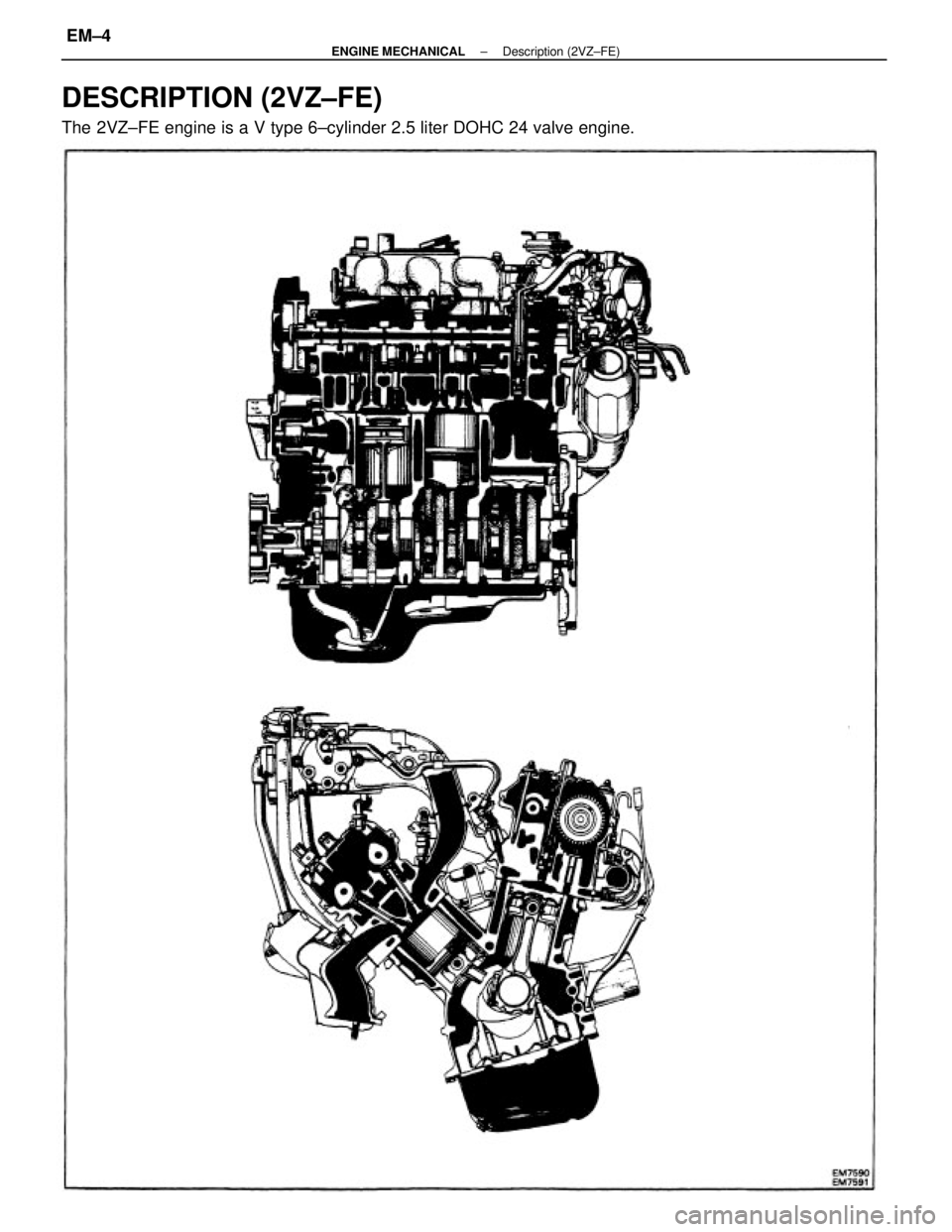
DESCRIPTION (2VZ±FE)
The 2VZ±FE engine is a V type 6±cylinder 2.5 liter DOHC 24 valve engine.
± ENGINE MECHANICALDescription (2VZ±FE)EM±4
Page 1182 of 2389
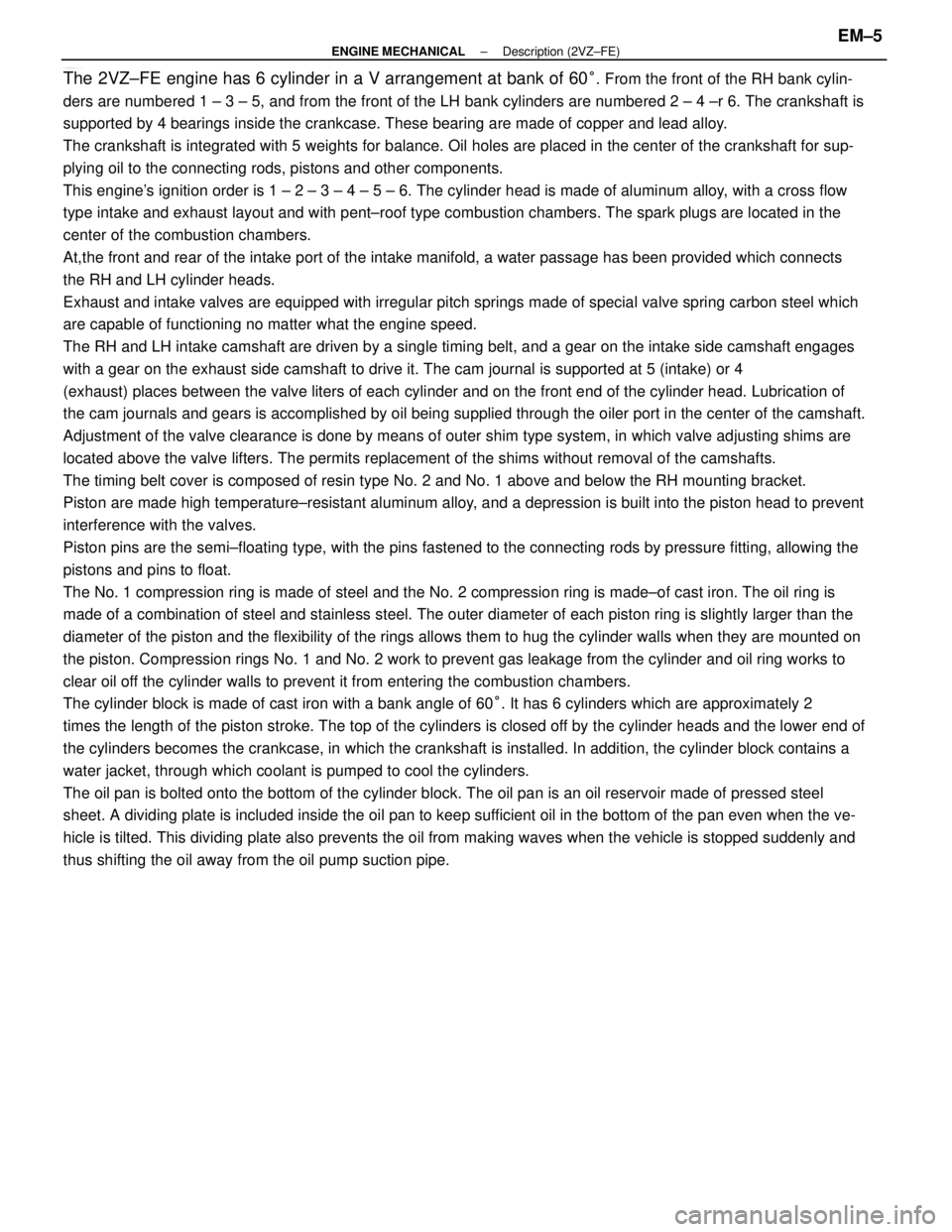
The 2VZ±FE engine has 6 cylinder in a V arrangement at bank of 60°. From the front of the RH bank cylin-
ders are numbered 1 ± 3 ± 5, and from the front of the LH bank cylinders are numbered 2 ± 4 ±r 6. The crankshaft is
supported by 4 bearings inside the crankcase. These bearing are made of copper and lead alloy.
The crankshaft is integrated with 5 weights for balance. Oil holes are placed in the center of the crankshaft for sup-
plying oil to the connecting rods, pistons and other components.
This engine's ignition order is 1 ± 2 ± 3 ± 4 ± 5 ± 6. The cylinder head is made of aluminum alloy, with a cross flow
type intake and exhaust layout and with pent±roof type combustion chambers. The spark plugs are located in the
center of the combustion chambers.
At,the front and rear of the intake port of the intake manifold, a water passage has been provided which connects
the RH and LH cylinder heads.
Exhaust and intake valves are equipped with irregular pitch springs made of special valve spring carbon steel which
are capable of functioning no matter what the engine speed.
The RH and LH intake camshaft are driven by a single timing belt, and a gear on the intake side camshaft engages
with a gear on the exhaust side camshaft to drive it. The cam journal is supported at 5 (intake) or 4
(exhaust) places between the valve liters of each cylinder and on the front end of the cylinder head. Lubrication of
the cam journals and gears is accomplished by oil being supplied through the oiler port in the center of the camshaft.
Adjustment of the valve clearance is done by means of outer shim type system, in which valve adjusting shims are
located above the valve lifters. The permits replacement of the shims without removal of the camshafts.
The timing belt cover is composed of resin type No. 2 and No. 1 above and below the RH mounting bracket.
Piston are made high temperature±resistant aluminum alloy, and a depression is built into the piston head to prevent
interference with the valves.
Piston pins are the semi±floating type, with the pins fastened to the connecting rods by pressure fitting, allowing the
pistons and pins to float.
The No. 1 compression ring is made of steel and the No. 2 compression ring is made±of cast iron. The oil ring is
made of a combination of steel and stainless steel. The outer diameter of each piston ring is slightly larger than the
diameter of the piston and the flexibility of the rings allows them to hug the cylinder walls when they are mounted on
the piston. Compression rings No. 1 and No. 2 work to prevent gas leakage from the cylinder and oil ring works to
clear oil off the cylinder walls to prevent it from entering the combustion chambers.
The cylinder block is made of cast iron with a bank angle of 60°. It has 6 cylinders which are approximately 2
times the length of the piston stroke. The top of the cylinders is closed off by the cylinder heads and the lower end of
the cylinders becomes the crankcase, in which the crankshaft is installed. In addition, the cylinder block contains a
water jacket, through which coolant is pumped to cool the cylinders.
The oil pan is bolted onto the bottom of the cylinder block. The oil pan is an oil reservoir made of pressed steel
sheet. A dividing plate is included inside the oil pan to keep sufficient oil in the bottom of the pan even when the ve-
hicle is tilted. This dividing plate also prevents the oil from making waves when the vehicle is stopped suddenly and
thus shifting the oil away from the oil pump suction pipe.
± ENGINE MECHANICALDescription (2VZ±FE)EM±5
Page 1183 of 2389
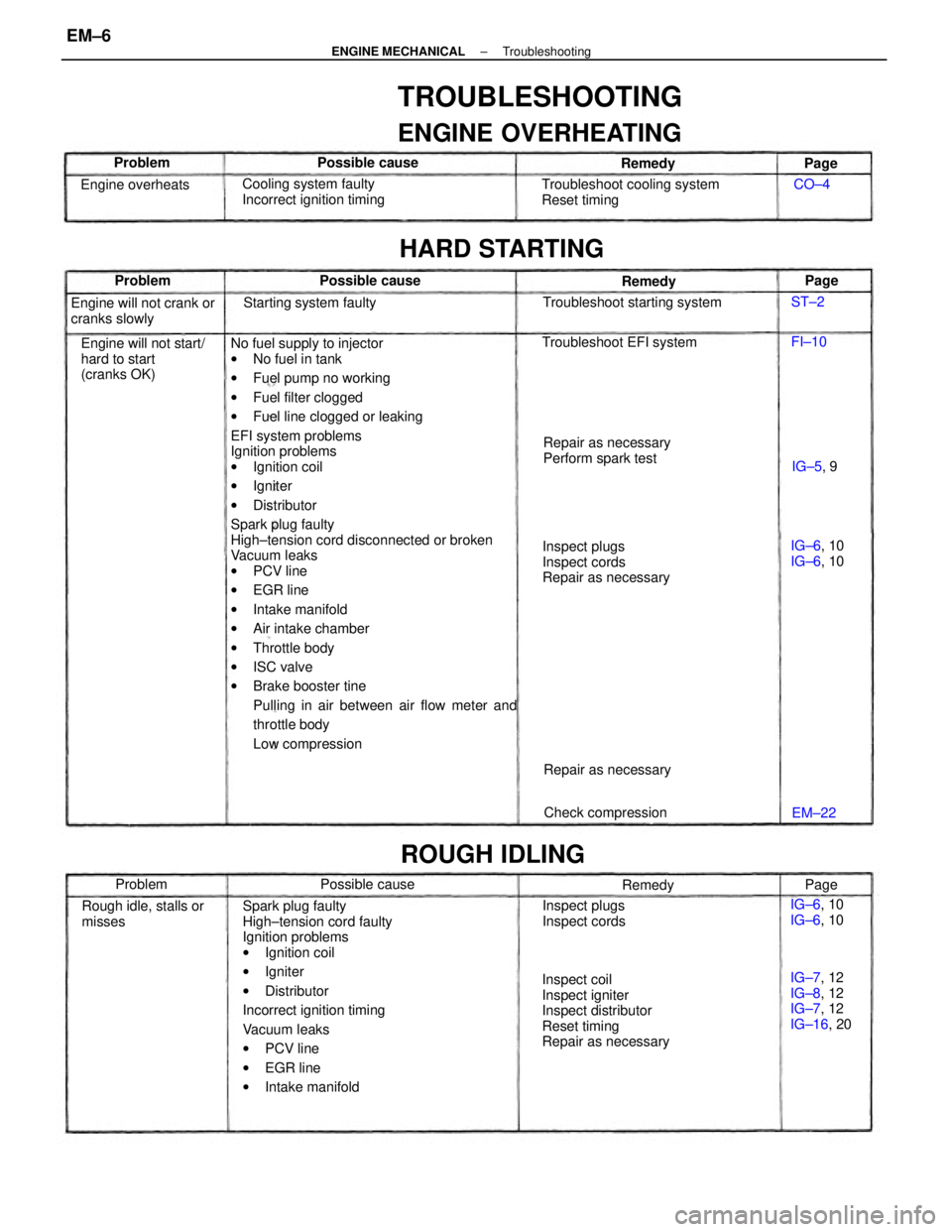
No fuel supply to injector
wNo fuel in tank
wFuel pump no working
wFuel filter clogged
wFuel line clogged or leaking
EFI system problems
Ignition problems
wIgnition coil
wIgniter
wDistributor
Spark plug faulty
High±tension cord disconnected or broken
Vacuum leaks
wPCV line
wEGR line
wIntake manifold
wAir intake chamber
wThrottle body
wISC valve
wBrake booster tine
Pulling in air between air flow meter and
throttle body
Low compression
Spark plug faulty
High±tension cord faulty
Ignition problems
wIgnition coil
wIgniter
wDistributor
Incorrect ignition timing
Vacuum leaks
wPCV line
wEGR line
wIntake manifold
TROUBLESHOOTING
ENGINE OVERHEATING
Inspect coil
Inspect igniter
Inspect distributor
Reset timing
Repair as necessaryInspect plugs
Inspect cords
Repair as necessary Troubleshoot cooling system
Reset timing
Engine will not start/
hard to start
(cranks OK)Cooling system faulty
Incorrect ignition timing
Repair as necessary
Perform spark test Engine will not crank or
cranks slowly
IG±7, 12
IG±8, 12
IG±7, 12
IG±16, 20 Rough idle, stalls or
misses
HARD STARTING
Troubleshoot starting system
Inspect plugs
Inspect cords Troubleshoot EFI system
ROUGH IDLING
Starting system faulty
Check compression Repair as necessary Engine overheats
IG±6, 10
IG±6, 10 IG±6, 10
IG±6, 10 Possible cause
Possible cause Possible cause
Remedy Remedy
Problem
Remedy Problem Problem
IG±5, 9
EM±22Page
Page
Page CO±4
FI±10 ST±2
± ENGINE MECHANICALTroubleshootingEM±6
Page 1184 of 2389

Spark plug faulty
High±tension cord faulty
Vacuum leaks
wPCV line
wEGR line
wIntake manifold
wAir intake chamber
wThrottle body
wISC valve
wBrake booster line
Pulling in air between air flow meter and
throttle body
Incorrect ignition timing
Incorrect valve clearance
Fuel system clogged
Air cleaner clogged
EFI system problems
Emission control system problem
(cold engine)
wEGR system always on
Engine overheats
Low compression Vacuum leaks (Cont'd)
wAir intake chamber
wThrottle body
wISC valve
wBrake booster line
Pulling in air between air flow meter and
throttle body
Incorrect idle speed
Incorrect valve clearance
EFI system problems
Engine overheats
Low compressionCheck ISC system
Adjust valve clearance
Repair as necessary
Check cooling system
Check compression
Reset timing
Adjust valve clearance
Check fuel system
Check air cleaner
Repair as necessary
ENGINE HESITATES/POOR ACCELERATION
Check EGR system
Check cooling system
Check compressionInspect plugs
Inspect cords
Repair as necessary
ROUGH IDLING (Cont'd)
Rough idle, stalls or
misses (Cont'd)
Engine hesitates/
poor acceleration
EC±8,21
Co±4
EM±22FI±116, 118
EM±11, 15
IG±16, 20
EM±11, 15 Repair as necessary
IG±6, 10
IG±6, 10 Possible causePossible cause
CO±4
EM±22 Remedy Problem
RemedyProblemPage
MA±5Page
± ENGINE MECHANICALTroubleshootingEM±7
Page 1185 of 2389
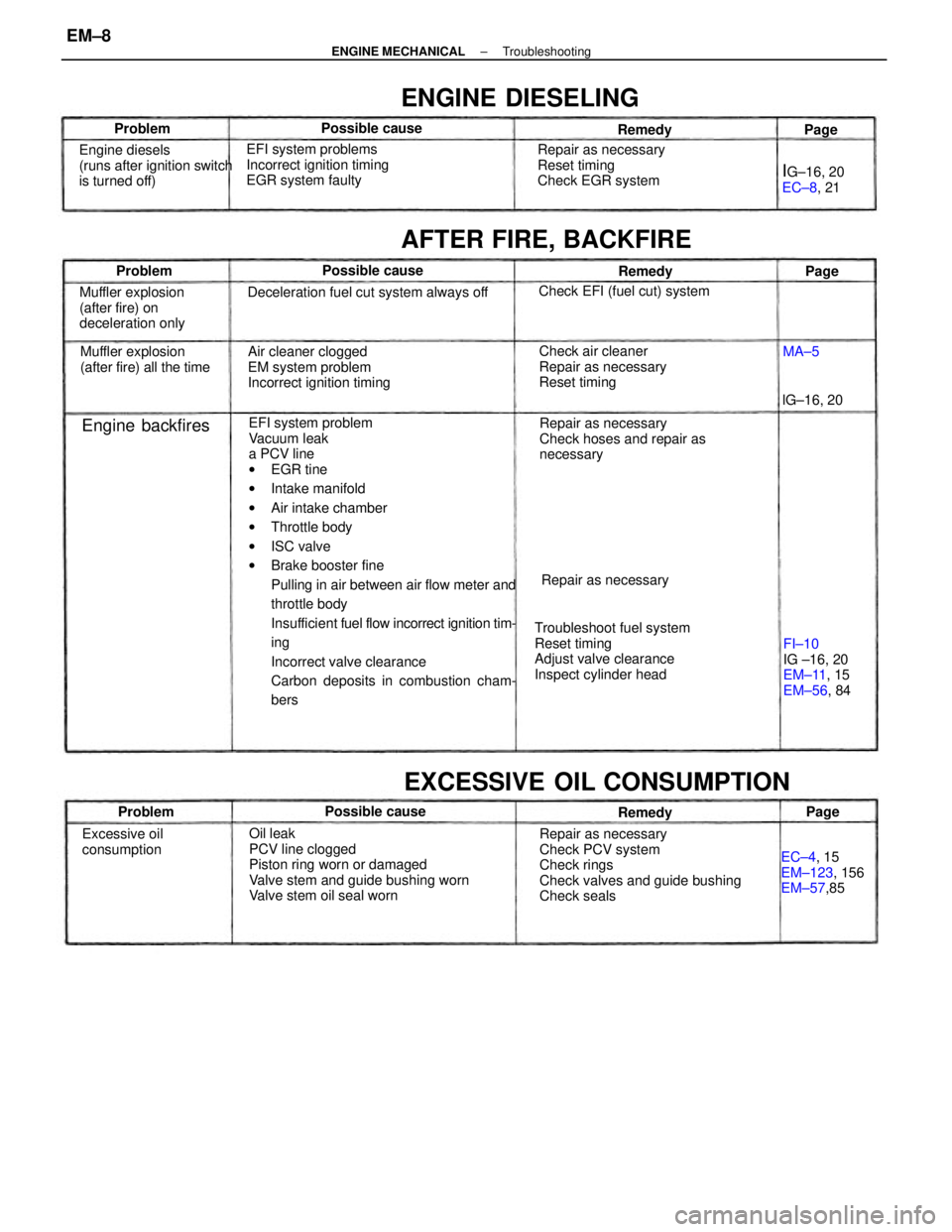
EFI system problem
Vacuum leak
a PCV line
wEGR tine
wIntake manifold
wAir intake chamber
wThrottle body
wISC valve
wBrake booster fine
Pulling in air between air flow meter and
throttle body
Insufficient fuel flow incorrect ignition tim-
ing
Incorrect valve clearance
Carbon deposits in combustion cham-
bers
Oil leak
PCV line clogged
Piston ring worn or damaged
Valve stem and guide bushing worn
Valve stem oil seal wornRepair as necessary
Check PCV system
Check rings
Check valves and guide bushing
Check seals Troubleshoot fuel system
Reset timing
Adjust valve clearance
Inspect cylinder headRepair as necessary
Check hoses and repair as
necessary Air cleaner clogged
EM system problem
Incorrect ignition timing EFI system problems
Incorrect ignition timing
EGR system faulty
Deceleration fuel cut system always off
Check air cleaner
Repair as necessary
Reset timing Repair as necessary
Reset timing
Check EGR system
EXCESSIVE OIL CONSUMPTION
Engine diesels
(runs after ignition switch
is turned off)
Muffler explosion
(after fire) on
deceleration only
FI±10
IG ±16, 20
EM±11, 15
EM±56, 84 Muffler explosion
(after fire) all the time
AFTER FIRE, BACKFIRE
EC±4, 15
EM±123, 156
EM±57,85
ENGINE DIESELING
Check EFI (fuel cut) system
Excessive oil
consumptionRepair as necessary
IG±16, 20
EC±8, 21
Engine backfires
Possible cause Possible cause
Possible causelG±16, 20 Problem
Problem
RemedyRemedy
ProblemRemedy
Page Page
MA±5Page
± ENGINE MECHANICALTroubleshootingEM±8
Page 1186 of 2389
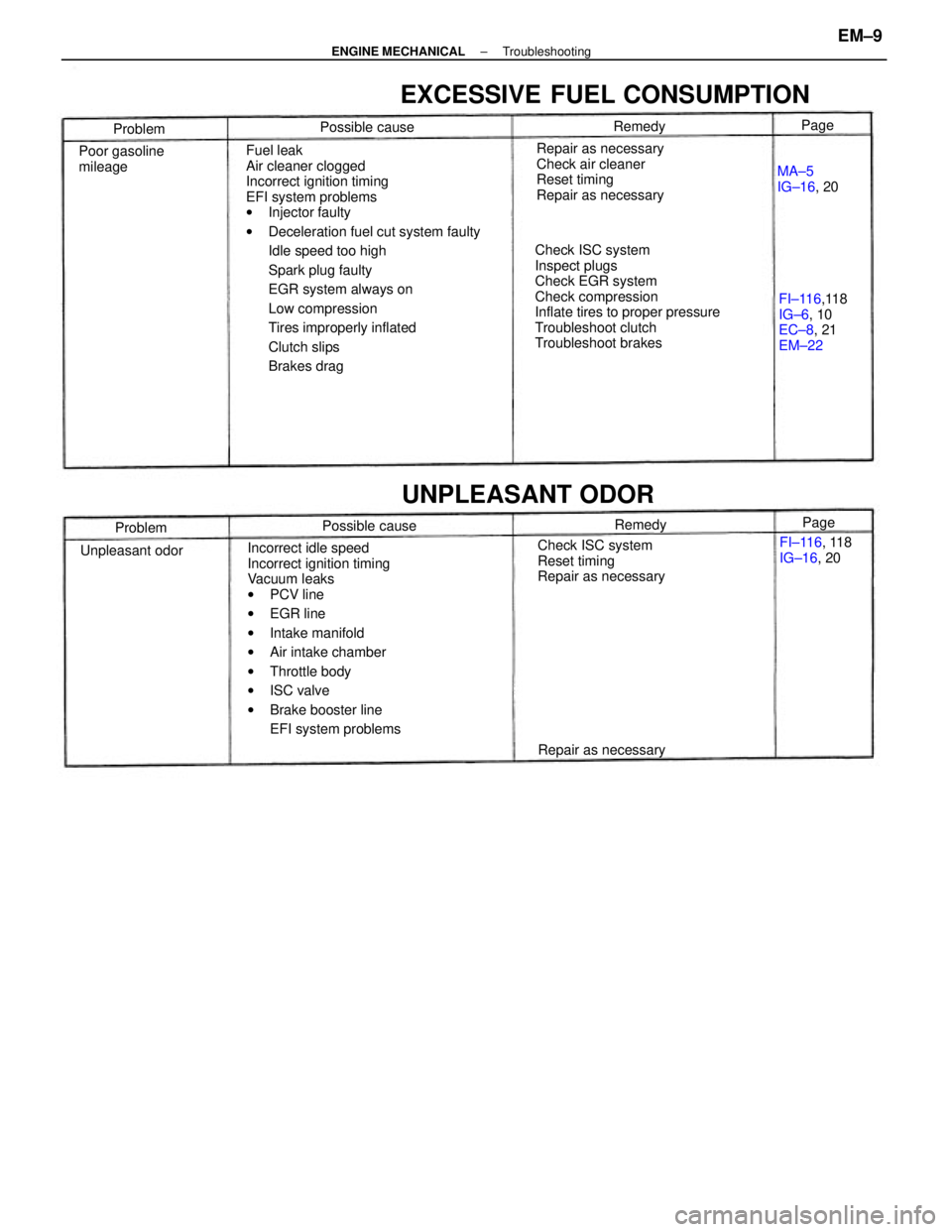
Fuel leak
Air cleaner clogged
Incorrect ignition timing
EFI system problems
wInjector faulty
wDeceleration fuel cut system faulty
Idle speed too high
Spark plug faulty
EGR system always on
Low compression
Tires improperly inflated
Clutch slips
Brakes drag
Incorrect idle speed
Incorrect ignition timing
Vacuum leaks
wPCV line
wEGR line
wIntake manifold
wAir intake chamber
wThrottle body
wISC valve
wBrake booster line
EFI system problemsCheck ISC system
Inspect plugs
Check EGR system
Check compression
Inflate tires to proper pressure
Troubleshoot clutch
Troubleshoot brakesRepair as necessary
Check air cleaner
Reset timing
Repair as necessary
EXCESSIVE FUEL CONSUMPTION
Check ISC system
Reset timing
Repair as necessaryFI±116,118
IG±6, 10
EC±8, 21
EM±22
UNPLEASANT ODOR
Poor gasoline
mileage
FI±116, 118
IG±16, 20
Repair as necessaryMA±5
IG±16, 20
Unpleasant odorPossible cause Possible cause
Problem
ProblemRemedy
RemedyPage Page
± ENGINE MECHANICALTroubleshootingEM±9
Page 1187 of 2389
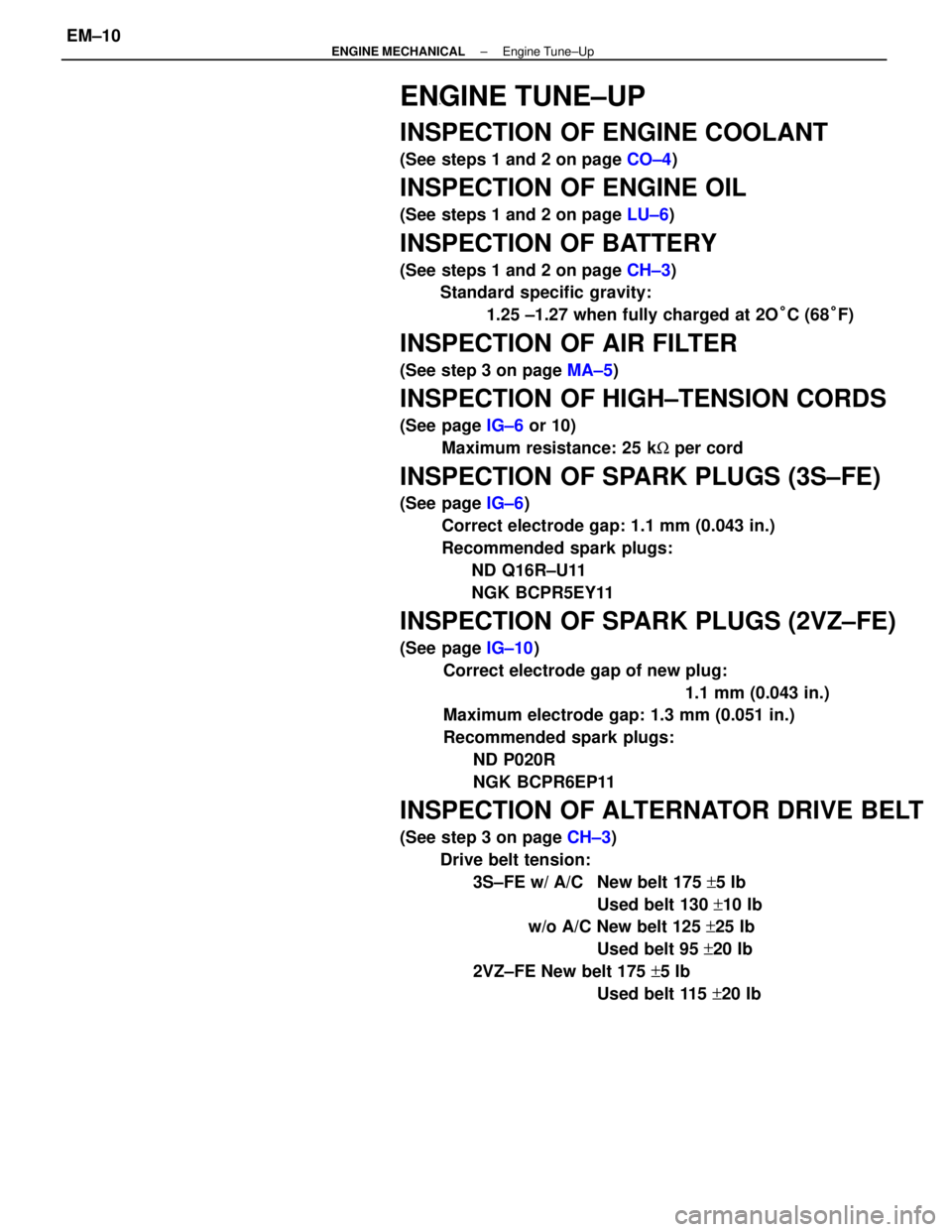
ENGINE TUNE±UP
INSPECTION OF ENGINE COOLANT
(See steps 1 and 2 on page CO±4)
INSPECTION OF ENGINE OIL
(See steps 1 and 2 on page LU±6)
INSPECTION OF BATTERY
(See steps 1 and 2 on page CH±3)
Standard specific gravity:
1.25 ±1.27 when fully charged at 2O°C (68°F)
INSPECTION OF AIR FILTER
(See step 3 on page MA±5)
INSPECTION OF HIGH±TENSION CORDS
(See page IG±6 or 10)
Maximum resistance: 25 kW per cord
INSPECTION OF SPARK PLUGS (3S±FE)
(See page IG±6)
Correct electrode gap: 1.1 mm (0.043 in.)
Recommended spark plugs:
ND Q16R±U11
NGK BCPR5EY11
INSPECTION OF SPARK PLUGS (2VZ±FE)
(See page IG±10)
Correct electrode gap of new plug:
1.1 mm (0.043 in.)
Maximum electrode gap: 1.3 mm (0.051 in.)
Recommended spark plugs:
ND P020R
NGK BCPR6EP11
INSPECTION OF ALTERNATOR DRIVE BELT
(See step 3 on page CH±3)
Drive belt tension:
3S±FE w/ A/C New belt 175 +5 Ib
Used belt 130 +10 Ib
w/o A/C New belt 125 +25 Ib
Used belt 95 +20 Ib
2VZ±FE New belt 175 +5 Ib
Used belt 115 +20 Ib
± ENGINE MECHANICALEngine Tune±UpEM±10
Page 1188 of 2389
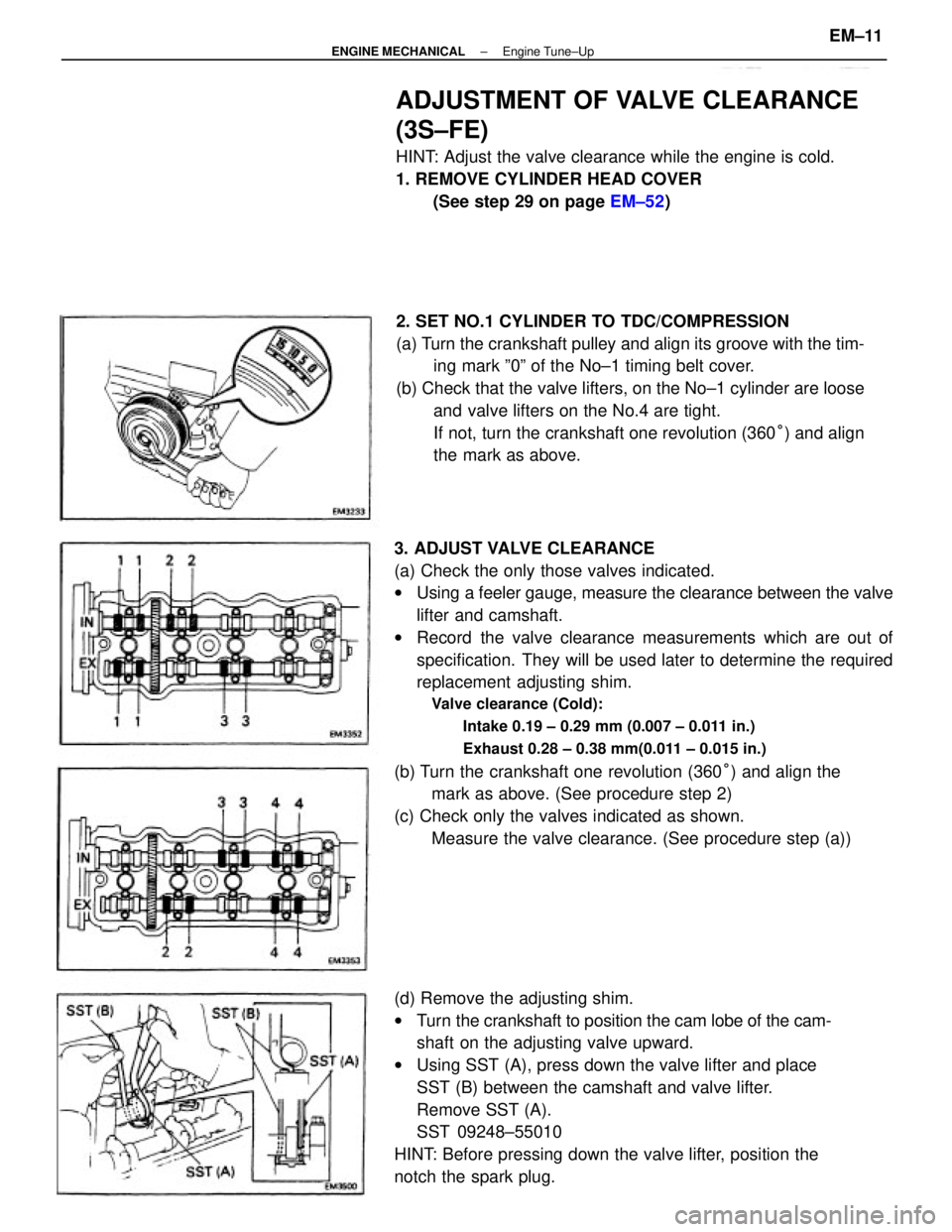
3. ADJUST VALVE CLEARANCE
(a) Check the only those valves indicated.
wUsing a feeler gauge, measure the clearance between the valve
lifter and camshaft.
wRecord the valve clearance measurements which are out of
specification. They will be used later to determine the required
replacement adjusting shim.
Valve clearance (Cold):
Intake 0.19 ± 0.29 mm (0.007 ± 0.011 in.)
Exhaust 0.28 ± 0.38 mm(0.011 ± 0.015 in.)
(b) Turn the crankshaft one revolution (360°) and align the
mark as above. (See procedure step 2)
(c) Check only the valves indicated as shown.
Measure the valve clearance. (See procedure step (a))
(d) Remove the adjusting shim.
wTurn the crankshaft to position the cam lobe of the cam-
shaft on the adjusting valve upward.
wUsing SST (A), press down the valve lifter and place
SST (B) between the camshaft and valve lifter.
Remove SST (A).
SST 09248±55010
HINT: Before pressing down the valve lifter, position the
notch the spark plug.2. SET NO.1 CYLINDER TO TDC/COMPRESSION
(a) Turn the crankshaft pulley and align its groove with the tim-
ing mark º0º of the No±1 timing belt cover.
(b) Check that the valve lifters, on the No±1 cylinder are loose
and valve lifters on the No.4 are tight.
If not, turn the crankshaft one revolution (360°) and align
the mark as above.
ADJUSTMENT OF VALVE CLEARANCE
(3S±FE)
HINT: Adjust the valve clearance while the engine is cold.
1. REMOVE CYLINDER HEAD COVER
(See step 29 on page EM±52)
± ENGINE MECHANICALEngine Tune±UpEM±11
Page 1189 of 2389
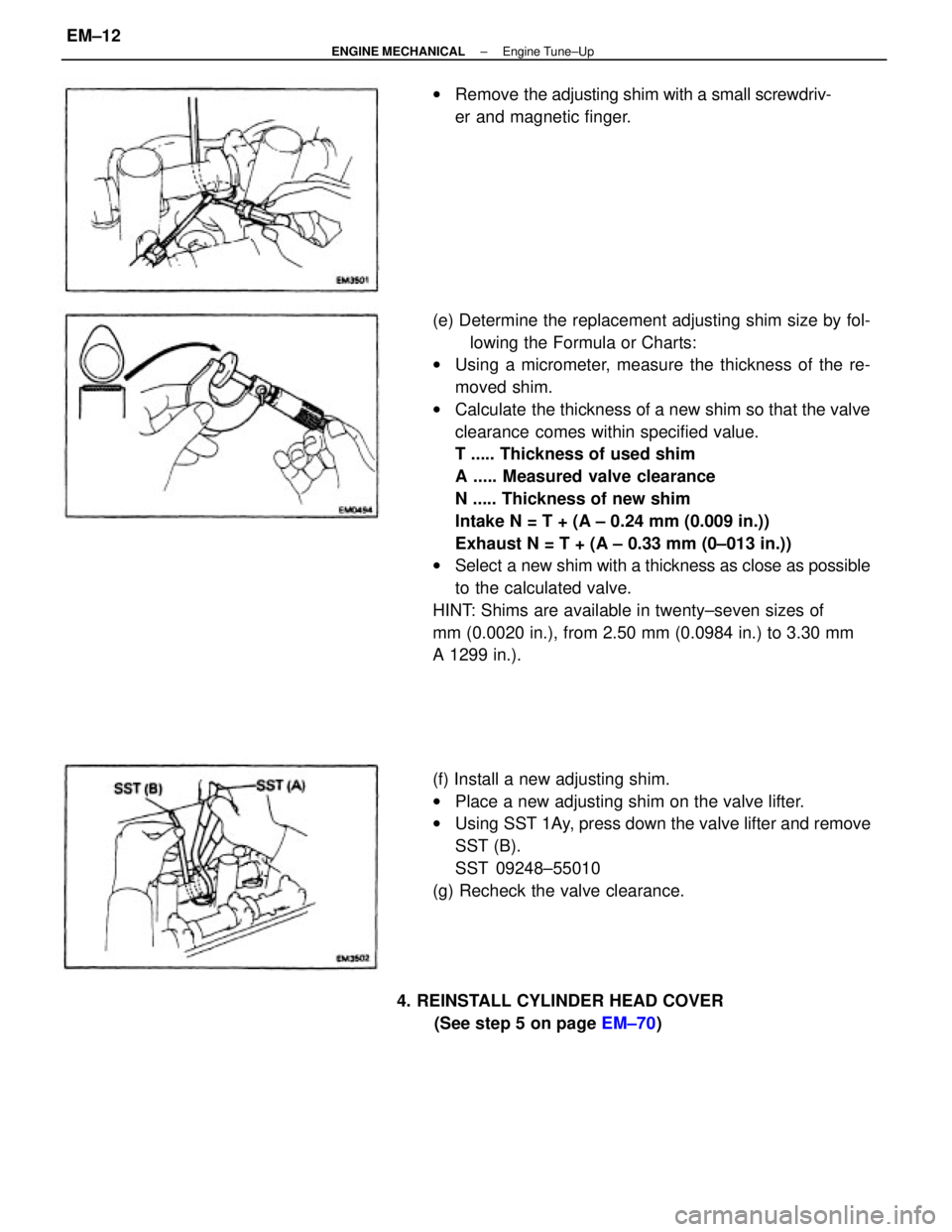
(e) Determine the replacement adjusting shim size by fol-
lowing the Formula or Charts:
wUsing a micrometer, measure the thickness of the re-
moved shim.
wCalculate the thickness of a new shim so that the valve
clearance comes within specified value.
T ..... Thickness of used shim
A ..... Measured valve clearance
N ..... Thickness of new shim
Intake N = T + (A ± 0.24 mm (0.009 in.))
Exhaust N = T + (A ± 0.33 mm (0±013 in.))
wSelect a new shim with a thickness as close as possible
to the calculated valve.
HINT: Shims are available in twenty±seven sizes of
mm (0.0020 in.), from 2.50 mm (0.0984 in.) to 3.30 mm
A 1299 in.).
(f) Install a new adjusting shim.
wPlace a new adjusting shim on the valve lifter.
wUsing SST 1Ay, press down the valve lifter and remove
SST (B).
SST 09248±55010
(g) Recheck the valve clearance. wRemove the adjusting shim with a small screwdriv-
er and magnetic finger.
4. REINSTALL CYLINDER HEAD COVER
(See step 5 on page EM±70)
± ENGINE MECHANICALEngine Tune±UpEM±12
Page 1190 of 2389
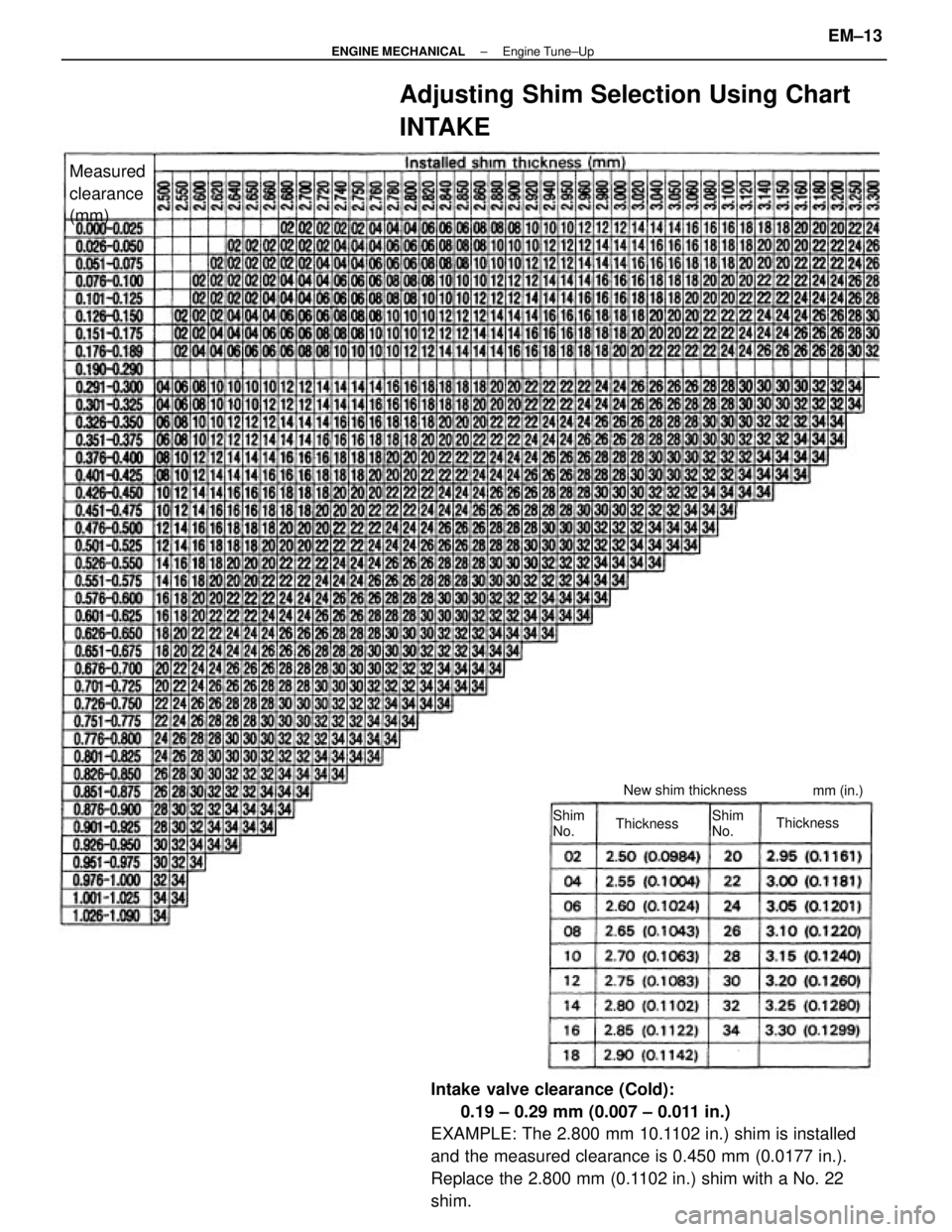
Intake valve clearance (Cold):
0.19 ± 0.29 mm (0.007 ± 0.011 in.)
EXAMPLE: The 2.800 mm 10.1102 in.) shim is installed
and the measured clearance is 0.450 mm (0.0177 in.).
Replace the 2.800 mm (0.1102 in.) shim with a No. 22
shim.
Adjusting Shim Selection Using Chart
INTAKE
Measured
clearance
(mm)
New shim thickness
Thickness
ThicknessShim
No.mm (in.)
Shim
No.
± ENGINE MECHANICALEngine Tune±UpEM±13